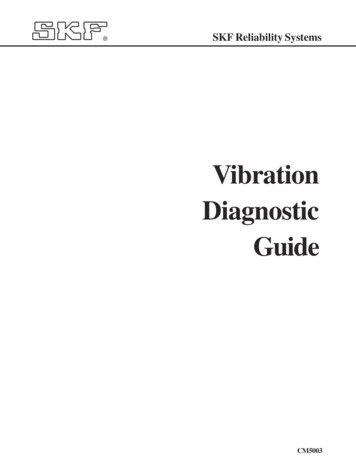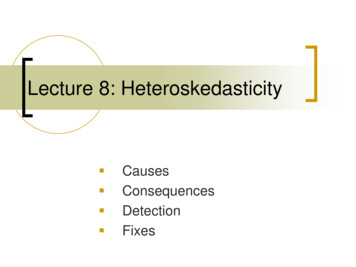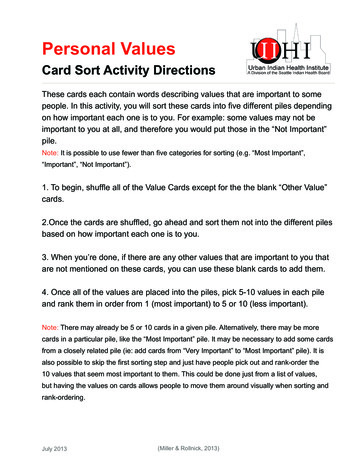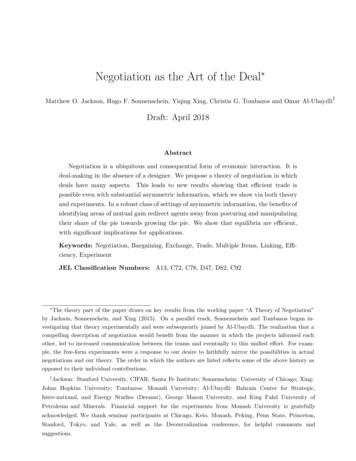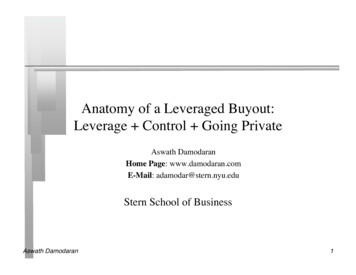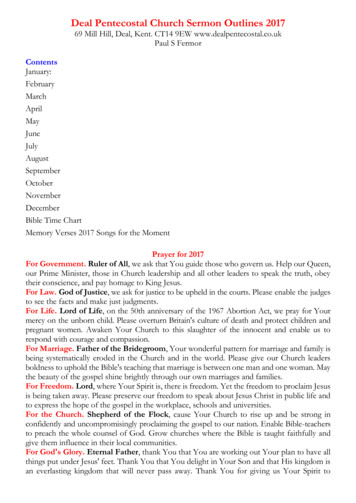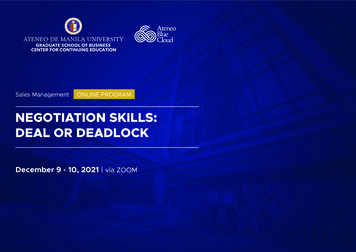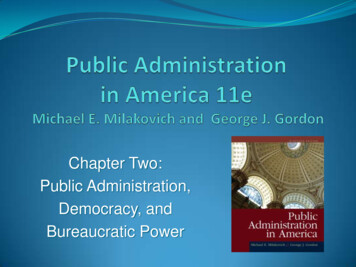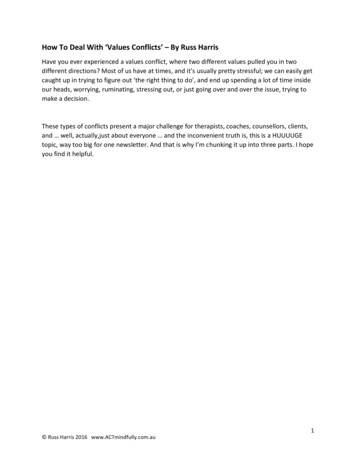
Transcription
How To Deal With ‘Values Conflicts’ – By Russ HarrisHave you ever experienced a values conflict, where two different values pulled you in twodifferent directions? Most of us have at times, and it’s usually pretty stressful; we can easily getcaught up in trying to figure out ‘the right thing to do’, and end up spending a lot of time insideour heads, worrying, ruminating, stressing out, or just going over and over the issue, trying tomake a decision.These types of conflicts present a major challenge for therapists, coaches, counsellors, clients,and well, actually,just about everyone and the inconvenient truth is, this is a HUUUUGEtopic, way too big for one newsletter. And that is why I’m chunking it up into three parts. I hopeyou find it helpful.1 Russ Harris 2016 www.ACTmindfully.com.au
PART 1: Is This A True ‘Values Conflict’?Before anything else, we need to get very clear about the differences between values, lifedomains, and goals. Once you truly understand these distinctions, a lot of so-called ‘valuesconflicts’ actually turn out to be something else: the real issue is not about conflicting values,but about how much time and energy to invest in different domains of life. So here’s a quickreminder of the difference between life domains, goals, and values:‘Life domains’ describe various areas or parts of my life – e.g. Work, study, family, friends,health, leisure, spirituality, parenting, marriage. (It’s often useful to choose a life domain first,before you start working on values and goals within that domain.)‘Goals’ describe what I want to have, complete, achieve, or do. Goals might include aiming toget a good job, or to earn more money, or learn a new skill, or complete a project on time, orbuy a house, or lose weight, or get a girlfriend, or start exercising, or read more, or socialisemore etc.Some goals describe how I want to feel; these are called ‘emotional goals’. Emotional goalsmight include aiming to have more thoughts and feelings of a certain type – e.g. happiness, selfconfidence, self-esteem – or aiming to get rid of thoughts and feelings of a certain type – e.g.guilt, anxiety, painful memories etc.So consider the life domain of ‘work’. My goals in that domain might include the career I wantto develop, the qualifications or experience I want to get, the job I’m searching for, the tasks orduties or roles I want to do well, the money I want to earn, the projects I want to complete, thepromotion I want to get, the strategy I want to implement, the networks I want to build, thehealth and safety issues I want to address, etc.In the life domain of health, goals might include the somewhat vague goals of ‘improvinghealth’ or achieving ‘good health’ (if possible), or more specific goals such as ‘to exercise daily’,or ‘to eat more fruit and vegetables’ or ‘to quit smoking’ etc.In the life domain of family, goals might include to spend quality time with the children, or saveup for a family holiday, or go on a family holiday, or buy food and clothes for the family, or readthe kids a bedtime story etc.2 Russ Harris 2016 www.ACTmindfully.com.au
Values describe the personal qualities I want to embody in my actions; the sort of person I wantto be; the manner in which I want to treat myself, others, and the world around me. So forexample, in the life domain of family, my values might include being loving, kind, honest, andcaring. In the life domain of work, my values might include being fair, trustworthy, reliable, andresponsible. In the life domain of health, my values might be self-caring, self-encouragementand self-compassion.Now once we’re clear on the difference between life domains, values, and goals, a lot ofapparent ‘values conflicts’ suddenly turn into something altogether different.For example, take the common issue of ‘family versus career’. Is this a values conflict? Itappears to be, but it isn’t. What we have named here - ‘family versus career’ – is not a pair ofconflicting values; it is simply two important domains of life. And the issue here is not aboutvalues; it’s about time management: how many hours a week do you invest in career, and howmany hours a week do you invest in family?Your values in the domain of work (e.g. being fair, trustworthy, reliable, and responsible) willnot change whether you spend one hour a week at work or fifty hours a week at work. Andlikewise your values in the domain of family (e.g. being loving, kind, honest, and caring) will notchange whether you spend one hour a week at home with the family, or fifty hours a week athome with the family.With this clarity, you can then make a choice: given your current life situation, and the manyconflicting demands on your time and energy, and the long term goals you have for both yourcareer and your family, what is the best way to invest your time in these different domains?Of course, there won’t be a perfect answer. You will probably need to experiment withadjusting the amount of time and energy you invest in these domains – and see what worksbest for you. And of course, it doesn’t have to be either one or the other. For example, if youchoose to work late at the office, or to go away on a business trip, you can still put aside time inyour workday to call home and read the kids a bedtime story.3 Russ Harris 2016 www.ACTmindfully.com.au
Here’s another example: ‘caring for myself versus caring for others’. Notice there is no actualvalues conflict here – the value is very clearly ‘caring’. The real issue here is: how much timeand energy do I invest in caring for myself (e.g. in the life domains of health, work, leisure) andhow much time and energy do I invest in caring for others (e.g. in the life domains of family,friends, parenting, marriage)? The value of ‘caring’ will be the same whether I am caring formyself or for others.And again, it doesn’t have to be either one on the other. For example, you can cook a healthymeal for the family dinner - which is both caring for yourself and also caring for your family. Oryou can take the whole family for a bike ride, which is caring for both yourself and for them.In summary then: if you encounter an apparent ‘values conflict’, the first step is to identify – arethere truly two conflicting values here? Or is it actually an issue of how I invest my time andenergy in two different domains of life?If it’s the latter, then you need to focus on goal-setting and action-planning: how are you goingto plan and structure your time? What goals are you going to pursue and what actions are yougoing to take in each of those different domains of life, within the time you have allotted? Youmay need to experiment from day to day, week to week, month to month to find out whatworks best for you. And very often, there just won’t be a perfect solution, so you’ll need tounhook from the unhelpful mind chatter, and make room for the uncomfortable feelings, thatare highly likely to show up, and be compassionate to yourself. ůƐŽ͕ ĚŽŶΖƚ ĐŽŶĨƵƐĞ ǀĂůƵĞƐ ǁŝƚŚ ΖƌƵůĞƐΖ͘ /Ĩ LJŽƵƌ ƚŚŽƵŐŚƚƐ ĐŽŶƚĂŝŶƐ ǁŽƌĚƐ ůŝŬĞ͗ ƐŚŽƵůĚ͕ ŚĂǀĞ ƚŽ͕ ŵƵƐƚ͕ ŽƵŐŚƚ͕ ƌŝŐŚƚ ƚŚŝŶŐ ƚŽ ĚŽ͕ ǁƌŽŶŐ ƚŚŝŶŐ ƚŽ ĚŽ͕ ŵLJ ƌĞƐƉŽŶƐŝďŝůŝƚLJ͕ ŵLJ ĚƵƚLJ Ͳ ƚŚĞŶ ƚŚĞƐĞ ĂƌĞ ƉŽƌďĂďůLJ ΖƌƵůĞƐΖ ƌĂƚŚĞƌ ƚŚĂŶ ǀĂůƵĞƐ͘ dŚĞƌĞ ĂƌĞ ŵĂŶLJ ǁĂLJƐ ƚŽ ůŝǀĞ Ă ǀĂůƵĞ͕ ŽŶůLJ Ă ĨĞǁ ǁĂLJƐ ƚŽ ĨŽůůŽǁ Ă ƌƵůĞ͘ Ž ƚŚĞ Ăŝŵ ŝƐ ƚŽ ĚĞĨƵƐĞ ĨƌŽŵ ƚŚĞƐĞ ƌƵůĞƐ͕ ĂŶĚ ĨŝŶĚ ƚŚĞ ǀĂůƵĞƐ ƵŶĚĞƌŶĞĂƚŚ ƚŚĞŵ͘ dŚĞŶ ĂĐƚ ĨůĞdžŝďůLJ ŽŶ ƚŚĞ ǀĂůƵĞ͘ ͘Ő͘ ZƵůĞ с Η/ ŵƵƐƚ ĚŽ ǁŚĂƚ ŵLJ ƉĂƌĞŶƚƐ ƚĞůů ŵĞ ƚŽ ĚŽΗ sĂůƵĞ ΖŚŝĚŝŶŐ ďĞŶĞĂƚŚ ƚŚĞ ƌƵůĞΖ с ďĞŝŶŐ ƌĞƐƉĞĐƚĨƵů ĐƚŝŶŐ ĨůĞdžŝďůLJ ŽŶ ƚŚĞ ǀĂůƵĞ͗ ƚŚĞƌĞ ĂƌĞ ƚŚŽƵƐĂŶĚƐ ŽĨ ǁĂLJƐ / ĐĂŶ ďĞ ƌĞƐƉĞĐƚĨƵů͖ / ĚŽŶΖƚ ŚĂǀĞ ƚŽ ŽďĞLJ ŵLJ ƉĂƌĞŶƚƐΖ ĞǀĞƌLJ ĚĞŵĂŶĚ ŝŶ ŽƌĚĞƌ ƚŽ ůŝǀĞ ƚŚĞ ǀĂůƵĞ ŽĨ ƌĞƐƉĞĐƚĨƵůŶĞƐƐ͘ KŬĂLJ Ͳ ƐŽ what if it is actually a genuine values conflict? We’ll get to that next.4 Russ Harris 2016 www.ACTmindfully.com.au
PART TWO: A ‘Formula’ For Genuine Values ConflictsIn part 1 we looked at confusion between values, goals and life domains, and I concluded withthis: if you encounter an apparent ‘values conflict’, the first step is to identify – are there trulytwo conflicting values here? Or is it actually an issue of how I invest my time and energy in twodifferent domains of life?So let’s look at how to deal with a true values conflict. Suppose there is something going on atyour workplace – e.g. bullying, harassment, victimization, dishonesty, corruption. And you can’tdecide whether to speak up about it or not. It seems that if you speak up, you’ll be living yourvalue of honesty – but there will be some very negative repercussions; you may lose your job,or become a target, which is goes against your value of self-care. On the other hand, if youremain silent, you will keep your job, and avoid being a target, thus living your value of self-care– but you’ll be going against your value of being honest.What’s the solution? Well, there’s a basically formula I follow for genuine values conflicts. Let’sgo through itStep 1: Identify the life domain where values conflict.(Only work on one life domain at a time!)In this case, the domain is work.Step 2: Identify the two main values that conflict: A and B.(Ensure they are values, not goals or ‘shoulds’ or rules.)In this case, the values are A) honesty and B) self-careStep 3: Think of values as being like the continents on a globe of the world.(No matter how fast you spin the globe, you can’t see all the continents at once. Some arealways at the front, and others are always at the back. It’s the same with values; theycontinually change position, throughout the day. Some come to the front, some go to the back.)5 Russ Harris 2016 www.ACTmindfully.com.au
So in this case, throughout the day at work, there will be times honesty comes to the front, andtimes self-care comes to the front.Step 4: Think of all the different ways - in this specific domain of life – that you can live valueA by itself, value B by itself, and both values A and B simultaneously.(Include everything from the smallest of actions to the largest of goals.)So in this case, throughout the day at work, ways to live value A – honesty – include: Honestly expressing your feelings and opinions in situations where there is no personaldanger for doing soBeing honest with yourself about how you are feeling, and how difficult the situation isBeing honest in your dealings with clients, customers, colleagues and co-workersAnd throughout the day at work, ways to live value B – self-care – include: Eating healthy snacks for morning and afternoon tea, instead of muffins and biscuitsBeing prudent and cautious about when and where and with whom you share your truefeelings and opinions; picking and choosing who you do this with, in situations where it issafe for you to do so.Getting some fresh air and exercise with a walk at lunchtimeAnd throughout the day at work, ways to live both value A and value B simultaneously –include: Combining any of the above options, where practical to do so.Practising self-compassion: This involves being honest with yourself about the emotionalpain and stress you are suffering – acknowledging how painful it is - while also treatingyourself with kindness and caring (e.g. through saying kind, supportive things to yourself,or doing a mindful self-compassion exercise).Step 5: Is there a dilemma you need to address?(A dilemma is a difficult situation where you have two options but they conflict with eachother.)So in this particular case, although you have addressed the values conflict – in that you havefound ways to live both values in this important domain of life – you still face the dilemma ofwhether to ‘blow the whistle’ or not. There are no easy answers for dilemmas. If this is whatyou face, then I’d suggest you follow the steps in part 3.6 Russ Harris 2016 www.ACTmindfully.com.au
PART THREE – Dealing With DilemmasWe’ve all, at times, had to grapple with a difficult dilemma. ‘Do I stay in this relationship - orleave?’, ‘Do I quit this job - or do I stay?’, ‘Do I enrol in that course - or the other one?’, ‘Do Ihave the operation - or not?’, ‘Do we try to have children - or not?’, ‘Do I buy this one - or theother one?’, ‘Do I want to live here - or there?’When we’re in these situations, our mind easily goes into overdrive, desperately trying tofigure out whatto do; to ‘make the right decision’. The problem is, it can take days, weeks, months - or evenyears in some cases, such as unhappy marriages or unfulfilling jobs – before we finally chooseone option over the other. And, in the meantime, we can easily spend our days wanderingaround in a thick psychological smog – endlessly pondering ‘Do I or don’t I?’ – and, in theprocess, we make ourselves anxious or stressed, and we miss out on life, here and now.So, how can ACT help us?Step 1: AcceptanceWhen my clients present their dilemmas, I start off by telling them, ‘You probably will notmake your final decision during our session today. It could happen – but it’s extremelyunlikely.’ And if you are facing a major dilemma in your life today, this is almost certainly truefor you; you are not likely to resolve it in the next 24 hours. Can you make room for thisreality? Struggling with it will only make it worse.Step 2: Costs & BenefitsSometimes a dilemma can be resolved by the ages-old common-sense method of a ‘costbenefit analysis’. In other words, write down a list of all the benefits and all the costs for eachoption. If you’ve already done this and it hasn’t helped, fair enough – at least you tried. But ifyou haven’t done this – or if you’ve done it half-heartedly – or you’ve done it in your head butnot on paper – then you should definitely give it a go. When you write it all down in black andwhite, that is a very different experience than thinking it through inside you head or talking itthrough with a friend - and it may help you finalise your decision. However,the inconvenient truth is this: the greater the dilemma, the less likely this method is to behelpful. (Why? Because if one option was obviously far better than the other, then youwouldn’t have a dilemma in the first place!)Step 3: No Perfect SolutionNext, recognise there is no perfect solution. (If there were, you wouldn’t have had a dilemmain the first place). So whichever choice you make, you are likely to feel anxious about it - andyour mind is likely to tell you, ‘That’s the wrong decision’, then point out all the reasons whyyou shouldn’t do it. If you’re waiting until the day there’s no feelings of anxiety, and nothoughts about making the wrong decision, you’ll probably be waiting forever.8 Russ Harris 2016 www.ACTmindfully.com.au
Step 4: There’s No Way Not To ChooseRecognise that whatever your dilemma is, you’re already making a choice. Each day you don’tquit your job, you are choosing to stay. (Until the day you hand in your resignation, you arestaying in that job.) Each day that you don’t leave your marriage, you are choosing to stay.(Until the day you pack your bags and move out of the house, you are staying in thatmarriage.) Each day that you don’t sign the consent form for the operation, you are choosingnot to have surgery.Step 5: Acknowledge Today’s ChoiceFollowing on from the above, kick off each day by acknowledging the choice you are making forthis day. For example, say to yourself, ‘Okay, for the next 24 hours, I choose to stay in themarriage’ or ‘For the next 24 hours, I choose to keep using contraceptives.’Step 6: Take A StandGiven your choice in step 5 above, what do you want to stand for in the next 24 hours? Whatvalues do you want to live by, in this area of life? If you’re staying in the marriage for anotherday, what sort of partner do you want to be for that one day? If you’re staying in your job foranother day, what sort of employee do you want to be for that one day?Step 7: Make Time To ReflectPut aside time on a regular basis to mindfully reflect on the situation. The best way to do this isas in step 2: using a diary or a computer, write down the costs and benefits of each option, andsee if anything has changed since last time you did this. You could also try to imagine what lifemight be like – both the positives and the negatives – a) if you went down one path, and b) ifyou went down the other path. For most people, ten to fifteen minutes 3 or 4 times a week ismore than enough reflection time – but you can put aside as little or as much as you like. Thekey thing is, make it focused; in other words, don’t try to do it at the same time as watching TVor doing housework or driving home or going to the gym or cooking dinner; just sit quietly withyour pen and paper or a computer, and do nothing else but reflect, as above, for the allottedtime.Step 8: Name The StoryThroughout the day, your mind will try to pull you back into the dilemma, over and over again.But if this was truly helpful, you’d already have resolved your dilemma, wouldn’t you? Sopractice ‘naming the story’. For example, try saying to yourself, ‘Aha! Here it is again. The“stay or leave” story. Thanks mind.’ Then focus your attention on doing some meaningful,values-guided activity. You will probably find it helpful to remind yourself, ‘I’ll think about thislater, in my scheduled reflection time’.9 Russ Harris 2016 www.ACTmindfully.com.au
Step 9: ExpandFeelings of anxiety will almost certainly arise - again and again and again – whichever optionyou choose. So practice expansion. Breathe into those feelings. Open up and make room forthem. Acknowledge to yourself, ‘Here’s anxiety.’ Remind yourself, ‘This is normal. It’s whateverybody feels in a challenging situation with an uncertain outcome.’Step 10: Self-compassionLast, but not least, be compassionate to yourself. Treat yourself gently. Talk to yourself kindly.Unhook yourself from all that unhelpful, self-judgmental mind-chatter, using whateverdefusion techniques you find best – e.g. thanking your mind, naming the story, silly voices.Remind yourself that you’re a fallible human being, not some high-tech computer that cancoldly analyse the probabilities and spit out an answer. Remind yourself that this is a verydifficult decision - if it were easy, you wouldn’t have a dilemma in the first place!Acknowledge that you’re in pain, you’re hurting. And do plenty of kind, caring, nurturing,considerate things for yourself; things that sooth or nurture or support you in this time ofhardship. This could include anything from spending quality time with close friends, takingcare of your body, treating yourself to a favourite leisure activity, making time for yourself topursue a sport or creative outlet, or even cooking a healthy dinner. It’s often helpful topractice some form of self-compassion meditation.***Recycle through these steps every day. If, over time, one option becomes much moreattractive than the other, or if it becomes no longer available to you, then fantastic – now youno longer have a dilemma. If, however, your dilemma remains unsolved, then at least you getto go through each day mindfully living by your values, instead of being lost in a smog ofanxious indecision. Plus, you’ll get plenty of practice at developing self-compassion.Other Types of Conflict?'ĞŶƵŝŶĞ ǀĂůƵĞƐ ĐŽŶĨůŝĐƚƐ ĂƌĞ ƋƵŝƚĞ ƌĂƌĞ ŝŶ ƚŚĞƌĂƉLJ͘ &Ăƌ ŵŽƌĞ ĐŽŵŵŽŶůLJ ǁĞ ĞŶĐŽƵŶƚĞƌ ŐŽĂů ĐŽŶĨůŝĐƚƐ͕ŵŽƐƚůLJ ĂƌŽƵŶĚ ŚŽǁ ƚŽ ĂůůŽĐĂƚĞ ƚŝŵĞ͕ ĞŶĞƌŐLJ͕ Žƌ ŵŽŶĞLJ͘ ͘Ő͘ Ζtŝůů / ƐƉĞŶĚ ŵLJ ƚŝŵĞͬĞŶĞƌŐLJͬŵŽŶĞLJ ƚŽ ĚŽǁŚĂƚ ŵLJ ƉĂƌƚŶĞƌͬƉĂƌĞŶƚƐͬ ĨƌŝĞŶĚƐͬĨĂŵŝůLJ ǁĂŶƚ Ͳ Žƌ ƚŽ ĚŽ ǁŚĂƚ / ǁĂŶƚ͍ ƚ ǁŽƌŬ͕ Žƌ Ăƚ ŚŽŵĞ͍ KŶ ŚŽďďLJ Žƌ ŽŶ ƉĂƐƚƚŝŵĞ ͍ Ž / ĚŽ ǁŚĂƚ ŵLJ ƌĞůŝŐŝŽŶͬĐƵůƚƵƌĞ ĚĞŵĂŶĚƐ Ͳ Žƌ ǁŚĂƚ / ƌĞĂůůLJ ǁĂŶƚ ƚŽ ĚŽ͍ΖsĂůƵĞƐ ĐůĂƌŝĨŝĐĂƚŝŽŶ ŝƐ ƵŶůŝŬĞůLJ ƚŽ ƐŽůǀĞ ƚŚĞƐĞ ĐŽŶĨůŝĐƚƐ͖ ŚŽǁĞǀĞƌ ŝƚ ĚŽĞƐ ƉƌŽǀŝĚĞ Ă ƐĞŶƐĞ ŽĨ ůŝďĞƌĂƚŝŽŶŝŶ ƚŚĂƚ ǁĞ ĐĂŶ ůŝǀĞ ďLJ ŽƵƌ ǀĂůƵĞƐ ǁŚŝĐŚĞǀĞƌ ĐŽƵƌƐĞ ŽĨ ĂĐƚŝŽŶ ǁĞ ƉƵƌƐƵĞ͘ hƐƵĂůůLJ LJŽƵΖůů ŶĞĞĚ ƚŽ ƵƐĞ ŽƚŚĞƌ ƐƚƌĂƚĞŐŝĞƐ to resolve theƐĞ ĐŽŶĨůŝĐƚƐ Ͳ ƐƵĐŚ ĂƐ ŵLJ ĚŝůĞŵŵĂ ΖǁŽƌŬŽƵƚΖ͕ Žƌ ǀĂƌŝŽƵƐ ĚĞĐŝƐŝŽŶͲŵĂŬŝŶŐ ƚŽŽůƐ͘10 Russ Harris 2016 www.ACTmindfully.com.au
example, in the life domain of family, my values might include being loving, kind, honest, and caring. In the life domain of work, my values might include being fair, trustworthy, reliable, and responsible. In the life domain of health, my values migh

